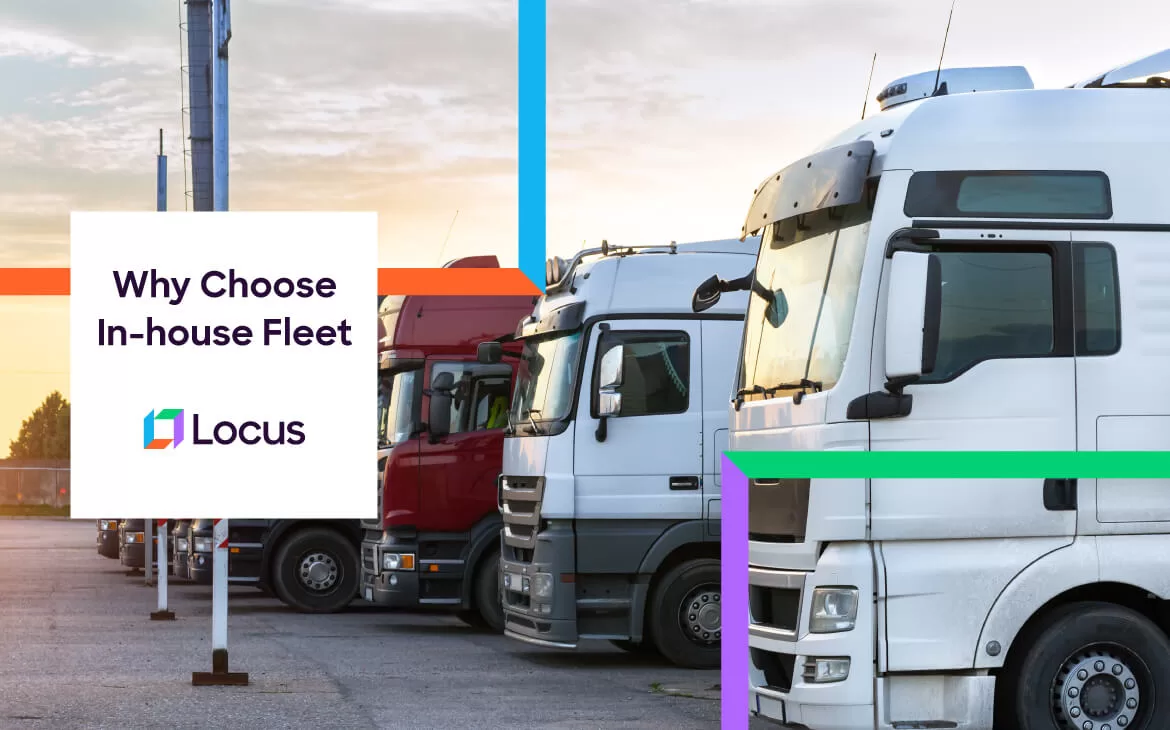Blog, Fleet Optimization, General
Why Choose In-house Fleet Over Outsourced Fleet Management for Your Delivery Business
Apr 29, 2022
7 mins read

In 2021, 44.5 percent of organizations worldwide revealed that they perceive customer experience (CX) as a primary competitive differentiator. – Organizations perceiving CX as a competitive differentiator worldwide 2021, Jan 2022.
Modern customers want a delightful experience from businesses. Delivery management, from the first to the last-mile, is key towards providing a lasting customer experience. As a fleet manager, you face pressures on a daily basis to manage the efficiency of deliveries without driving up operational costs. In pursuit of this quest, it is difficult to choose between running an in-house fleet or relying on outsourced ones.
But you are not alone! Alternatively, even if you plan to operate a hybrid delivery model using a mix of in-house and outsourced fleets, it can be difficult for you to obtain the right fleet mix. But before making such decisions, it is crucial to understand the difference between an in-house and outsourced fleet.
Difference between in-house fleet and outsourced fleet
There are significant differences between in-house and outsourced fleet services across a few factors as listed below.
| Factor | In-house fleet | Outsourced fleet |
|---|---|---|
| Control | A greater level of control over the delivery operations. | More chances to lose some control over delivery operations. |
| Customer experience | Greater control over logistics enables businesses to build a strong and deep level of connection with customers on the field. | The existence of middlemen could result in a fall in customer engagement. |
| Communication flow | Communication flow is effective and direct between customers and businesses and fleet managers and drivers. | Difficult to expect an efficient flow of communication as logistics partners handle the communication channels. |
| Visibility | Full visibility of delivery operations. | Chances of losing some visibility over your logistics operations. |
| Investment | A sizable upfront capital investment is required. But over time, greater flexibility and higher control yield decent returns for companies of smaller scale. | It may not require upfront capital investment but it has to deal with rising average delivery cost per order as it’s business requirements increase. |
| Accountability | The accountability of the workforce is higher for in-house fleets as they directly report to you. Also, you have direct communication with customers and can take detailed feedback to improve your business. | If the logistics partner commits a mistake, it reflects on your company. You are only outsourcing the workload, but still answerable to the customer. |
Reasons why delivery businesses should choose in-house fleet over outsourced fleet operations

As a delivery business grows in size, many logistics experts argue that it is better to offload their fleet operations and focus on revenue-generating tasks. Modern customers want an exceptional quality of delivery services that are consistent with the brand. With an in-house fleet, It is possible to deliver the same as you take the full responsibility of delivering products and services safely and securely to your customers. This means there is greater scope to offer more personalized delivery services. Find out the other crucial reasons a delivery business should choose an in-house fleet over outsourced fleet operations.
Complete control over delivery operations
Being a delivery business, there are times when you face peaks in delivery volumes and there are times when you experience a downfall in delivery demand. To shape your delivery process based on varying demands at your current scale requires efficient planning. The best way to plan your present and future delivery process is by having complete control over it.
By using in-house fleet, delivery businesses can shape their fleet to meet current demand keeping an eye on future delivery requirements Greater control helps you potentially rein in costs during slow seasons, and have a more granular approach to optimizing operations that in turn, can reduce costs.
Has potential for minimizing delivery costs
Experts who recommend outsourcing fleets mention that fewer costs are incurred with this method. But not always. As logistics service providers have a profit margin in addition to the delivery service they offer, the cost per delivery can be significantly higher when we factor the waiting time, surcharges or extra fees.
While operating an in-house fleet requires a sizable investment and involves overhead costs, it is a worthy investment for delivery businesses of a certain scale as it can potentially offer better returns from the flexibility around its delivery process. With an in-house fleet, you have full control over the cost structure and operational efficiency of deliveries. This control can be used to optimize operations, reduce costs and improve agility.
Example:
A meat company has a steady base of demand for the delivery of its processed meat. Using an in-house fleet can generate healthy returns over time despite its ongoing costs and upfront capital investment. By using fleet routing software, the meat company can optimize the routes appropriately to reduce the empty miles driven, saving huge operating costs.
Makes communication efficient
In a survey on customer experience (CX) among businesses conducted in the United States in 2021, participants were asked what are the main challenges to optimize customer journeys. The main challenge, indicated by 39.9 percent of the respondents, appeared to be the lack of inter-departmental collaboration. – Main challenges in optimizing customer journey for CX in the United States 2021, Jan 2022
Delivery businesses have a low-profit margin. For a business with such low rates of profit, it is necessary to strictly improve efficiency and cut unwanted costs. An efficient network of communication is foundational to simplify the delivery process and improve its profitability.
In an in-house fleet, the flow of communication between delivery agents and fleet managers takes place more effectively, largely because they are all part of the same organization. Thus, they are more familiar with each other, and the company values, and are more likely to pay greater attention to customer satisfaction.
Helps improve customer experience
Modern customers want a high level of care from any businesses they interact with, be it online-based or brick-and-mortar stores. They will continue buying products from them only if they feel that they value them. To build trust and build a deeper level of connection among customers, it is necessary for delivery businesses to build, train and operate a delivery workforce that prioritizes customer experience above all else.
An in-house fleet helps them instill company philosophy and make sure the workforce gets on the same page in terms of customer service practices. By enabling the customers to interact with the single seller, it increases customer engagement.
In 2021, more than 48 percent of organizations worldwide revealed that for them one of the most important drivers of customer experience (CX) is improving customer engagement. – Most important drivers of CX for organizations worldwide 2021, Jan 2022
When you outsource your deliveries to a logistics provider or partner, they hire different drivers and delivery agents from project to project. Changing the workforce for every project means they will be less aligned with your company’s vision for delivering customer excellence at any given time. With an in-house fleet, you can build a highly committed team towards delivery goals and this in turn helps you provide better service.
Conclusion
During the survey, 45 percent of organizations stated that they thought artificial intelligence solutions will reshape their customer experience (CX) in the next five years. – Organizations perceiving CX as a competitive differentiator worldwide 2021, Jan 2022.
Delivery businesses have started developing a renewed focus on the quality of service and customer experience. The globe is moving towards a post-pandemic recovery slowly, and customers are now factoring purchase decisions based on how well a delivery service cares for their preferences. The more a business satisfies the customer in its delivery service, the better the customer loyalty and higher the revenues.
The decision to move with in-house fleet operations is incomplete without choosing the right technology partner. Locus’s last-mile delivery software has been one of the best tech partners in helping in-house delivery operations of various businesses and minimize their operational costs. Its routing solutions help your in-house fleet operations to handle varying delivery demands over a period. Its real-time tracking and competent geocoding engine helps improve your on-time delivery rates and productivity of fleet operations.
To elevate your operational efficiency and minimize your fleet costs, try a demo with us now!
Related Tags:

Blog
All Play and No Work at Locus Sports Day 2022!
Our annual sports meet was conducted at the Locus headquarters in Bangalore. Table tennis, chess, football, and other indoor-outdoor sports are played.
Read more
Tech and Product
How AI and Logistics Tech Can Boost Van, Truck & DSD Sales in the Middle East
Since the end of the 20th century, Middle Eastern countries have been working towards diversifying their largely oil-based economies. Tourism and consumption have been two of the many pillars of diversification, and have been the catalysts for the emergence of a large and mature retail sector in these countries. In our previous article, we have […]
Read moreMOST POPULAR
EDITOR’S PICKS
SUBSCRIBE TO OUR NEWSLETTER
Stay up to date with the latest marketing, sales, and service tips and news


Why Choose In-house Fleet Over Outsourced Fleet Management for Your Delivery Business